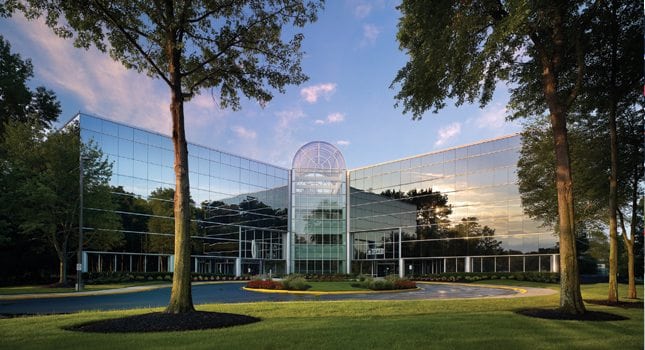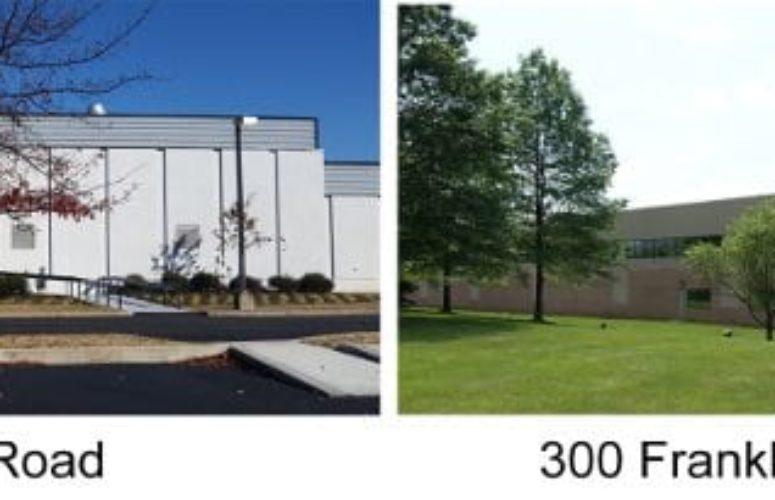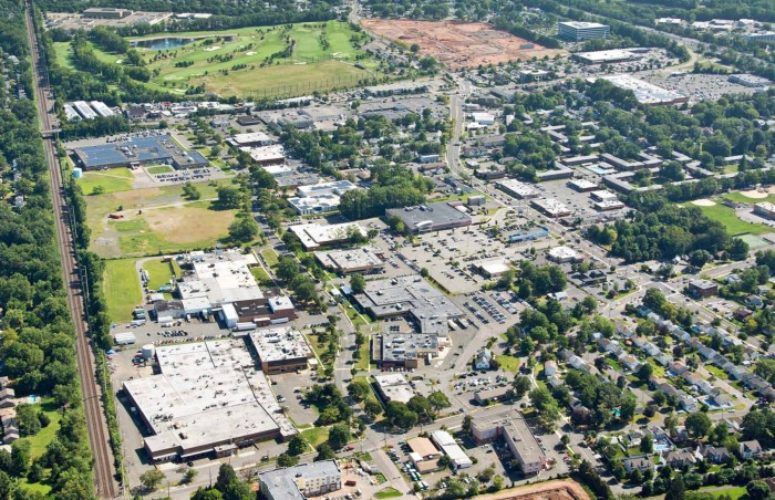
A Slow Bounce-back, but Some Optimistic Signs in Office Market
Urban areas are in demand while suburban spaces seek reinvention.
By Eric C. Peterson, Contributing Writer On Jul 7, 2014Slow economic and job growth continues to hinder the rebound of New Jersey’s office market. Urban markets, fueled by changing lifestyles and economic incentives, are outperforming the suburbs, but key deals are being done in both places. Adaptive re-use has become a mantra, particularly for older suburban product. And experts are mixed on what lies ahead. That, in a nutshell, is the condition of New Jersey’s office market.
According to Robert Rudin, vice chairman of Cushman & Wakefield, East Rutherford, the market is actually out-performing the state’s economy, which has recovered only 55 percent of pre-recession jobs. “There is a direct correlation between job growth and availability rate, and it’s surprising how many large transactions are being done now,” he says.
That hasn’t resulted “in a net diminution of space, because companies vacate something large to go into something else,” Rudin says. And “something else” can be downsizing.
Joshua Levering, senior vice president of NAI James E. Hanson, Parsippany, puts the statewide office vacancy rate at 15.4 percent, and an average rental rate of $25.30, numbers that vary dramatically from market to market and, overall, “haven’t changed much in the past year.”
With those numbers, “the market maintains its tenant friendliness,” says Gregg Najarian, senior vice president of Savills Studley in Hackensack. One possible omen for an increase in activity: “The tremendous amount of lease roll in the next three to six years —north of 60 percent of the market,” he says. “That’s not insignificant.”
“The market is getting better — we’re seeing more activity, more inspection activity,” says Jerry Barta, vice president of Alfred Sanzari Enterprises, Hackensack, whose signature property is the mixed-use Glenpointe Centre in Teaneck. “Activity is certainly not where I’d like to see it, but it’s been a long time since I’ve been able to say it’s getting better.”
The bottom line: “Every tush needs a chair, every chair needs a desk and every desk needs a certain amount of space,” Barta says. “If you don’t have the tushes filling the space, the snowball won’t roll downhill. New Jersey has some employment issues. Employment drives occupancy, and right now we’re not adding enough jobs.”
As for tenant sectors, “there is tremendous activity in pharmaceuticals, driven largely by M&A activity and spin-offs,” Najarian says, noting as well that “the biotechs are establishing a presence and continuing to grow.”
“The technology sector is very active,” says Matthew Dolly, vice president of Morristown-based Avison Young. “Healthcare is somewhat active, but still waiting to iron out the new healthcare regulations. Telecommunications is growing at a fast pace, and law firms are active.”
“Financial services are kind of flat,” says Richard Johnson, partner/principal of Matrix Development Group, Monroe Township. “Among law firms, there is activity in some and retrenchment in others, and technology-related companies are strong.”
Some of the overall activity, however, involves “consolidations of multiple locations into one, cutting back on square footage, perhaps trading down in rental rate and locking in some better economics,” Johnson says.
In the city vs. suburbs scenario, with the former said to be outperforming the latter, “the young generation enjoys 24-hour cities with lots to do,” Levering says. “Technology, medical, media and pharmaceutical companies want to make sure they have this incredible talent at their fingertips, and most of the younger talent pool is very adept within urban environments.”
“One of the emerging factors in office location is ‘where can my workforce live?’” Johnson says. “If your company relies on a lot of talent, you’ll take a serious look at an urban location, even if it costs more. You can take less space and pay a little more because your amenities are right outside your door — and you can forego putting them inside your building.
“If you choose to locate in the suburbs, you better make sure those amenities are either adjacent to your location, or put them in the building yourself,” he continues.
“Suburban sprawl is ending and more companies are moving toward transportation centers,” Dolly says. “There are a number of factors — gas prices, for one, create a reason for not wanting a long commute. At Avison Young, we are expanding and considered locating outside of Morristown. Our employees, by a landslide, wanted to stay in Morristown.”
“There has been a combination of a residential renaissance in the cities, which is peaking, and a revitalization of downtowns,” Rudin notes. Savvy civic leaders are taking advantage of that, he says, specifically noting Mayor Steven Fulop of Jersey City, who is “putting together a compelling vision for the city involving the arts, residential and commercial development.”
“Developers along the waterfront and Mayor Fulop of Jersey City are more focused on the live/work/play environment,” Dolly agrees. “They’re trying to compete with New York City and show them the New Jersey waterfront is a lot more affordable.”
Then there are “in between” markets. One is the Meadowlands which, while not urban, is close enough to the urban centers to become “one of the hottest markets in Northern New Jersey,” Najarian says. For example, his firm put Shiseido into a full floor at 301 Route 17 North based on proximity to New York, public transportation and amenities. Also, the owner, a partnership of Onyx Equities and SL Green “has been uber aggressive.”
Another “in between” location is that surrounding Glenpointe Centre in Teaneck. It’s not truly urban, but “there are few true suburban areas in Bergen County because it’s such a mature, developed part of the state,” Barta says.
In South Jersey, “we don’t have the same density as Northern New Jersey,” notes George Sowa, executive vice president of Brandywine Realty Trust, Mt. Laurel. “The best properties are located right at Turnpike or Interstate interchanges. In good times and bad, the best buildings in the best locations will always find tenants.”
Statewide, the suburban markets performing the best are Princeton, Metropark and Short Hills, according to Rudin.
And in general, suburban office product is, in a word, aging. “We built 80 percent of the office product between the mid-‘80s and early ‘90s,” Johnson notes. “Most of that space was built before we really understood, or even saw, the impact of PCs, cell phones and the Internet. A lot of the location decisions made back then are now completely invalid.”
Which broaches the topic of adaptive reuse for obsolete suburban offices. “We’re still trying to figure out what that means,” Levering says. “There is a ton of office that is antiquated, and people are trying to figure out a potential adaptive reuse.” Indeed, “razing is very much an adaptive reuse,” he says, noting specifically Hartz Mountain, “which is starting to raze buildings and replace them with things like data centers.”
“Towns will have to get used to the idea that ratables they have historically relied on are not going to be there,” Rudin says. “They’re going to have to be more creative about what happens to the land, because leaving it fallow is the worst solution.”
“We are currently working with several townships to reposition buildings,” Sowa says. One alternative: Mixed use, “to create some urban attributes within a suburban setting. In one instance, we converted a site previously approved for an office building and got it re-zoned for a hotel and two restaurant pads to create a nice amenity base for our surrounding office portfolio.”
Adaptive reuse also comes into play in the real estate owned market. “People are becoming comfortable with it, so we’re seeing a lot of properties that several years ago had too much debt, no tenancies and were tied up in the debt market starting to come to market,” Levering says. “People are repositioning or renovating these properties so they work.”
If a 30-year-old office building can’t compete in this market, how can an 80-year-old urban building? “With move-ins, tenancies come complete with gut renovations of the interior space so everything is brand new,” explains Miles Berger, chairman/CEO of The Berger Organization, Newark. “Every wall, ceiling and floor is brand new, as are HVAC and lighting, and the improvements are done over the years as space becomes vacant.
“The process is often influenced by the walls being in the wrong place, so we start moving walls and everything else goes with it,” Berger says. “The tendency in the suburbs has been to try to refit the new tenant into the existing space, but it doesn’t always work.” Berger describes office activity in Newark as “brisk,” particularly in the B and B+ market, where he is “seeing expansion of tenants and moves within Newark.”
Key recent urban deals include JP Morgan Chase’s expansion in Jersey City, fueled by a $225-million Grow NJ tax incentive, retaining 2,612 jobs and creating 1,000 new jobs; and Pearson Education’s relocation from Upper Saddle River to 200,000 square feet at SJP Properties’ Waterfront Corporate Center in Hoboken, with the help of $66 million in state incentives. Mack-Cali Realty Corp. is discussing plans for a new mixed-use development on Pearson’s former Upper Saddle River site.
Also, Forbes Media is relocating from Manhattan to 92,720 square feet at 499 Washington Blvd. in Jersey City with the help of a $27-million Grow NJ tax grant; Goya Foods is building a new headquarters in Jersey City; Thomson Reuters has taken an additional 72,000 square feet at Waterfront Corporate Center in Hoboken; the law firm McElroy, Deutsch, Mulvaney & Carpenter, LLP is relocating within Newark from Gateway to Berger’s 570 Broad Street; and Panasonic has relocated from Secaucus to Newark.
Key suburban deals include Valeant Pharmaceuticals’ 310,000-square-foot US headquarters lease at SJP Properties’ Somerset Corporate Center in Bridgewater; GAF’s headquarters consolidation in Parsippany; Celgene Corp.’s 550,000-square-foot headquarters expansion in Summit; ASTOne’s 45,000-square-foot lease at KABR Group and Kushner Cos.’ 55 Challenger Road in Ridgefield Park; and Towers Watson’s 60,000-square-foot lease at Brandywine’s 187,000-square-foot 10000 Midlantic Drive in Mt. Laurel, a site that will be utilized as a healthcare-related call center.
Predictions for the near term remain mixed. “There is more price pressure than there has been, and even with that pressure, there is activity, which is a positive sign,” Barta says. “The chain of events has to start somewhere. Still, I think it’s going to be relatively tough sledding. A lot of what’s going on is companies upgrading their facilities, from a B+ to an A building, or from a C to a B because rents are still somewhat down.
“Unfortunately, there’s some ‘musical chairs’ going on, and hopefully the music stops when they’re next to my chair,” he says.
Najarian agrees: “In think there is going to be continued ‘musical chairs,’ but in some cases that will involve better opportunities for tenants, especially larger ones, because they’re able to do gut rehabs of 30-year-old buildings and bring them into the 21st century. There will be continued challenges in the major suburban markets unless landlords spend the money.”
“The market is highly fractured in that each building has a unique value, so the market’s not strong enough to lift all boats,” Rudin says. “You can have a building selling for $50 a foot, that’s not leased, within a half-mile of a building that is leased and selling for $250 a foot. The market really hasn’t become rational, but there are many opportunities with buildings that currently don’t have economic value, that can be acquired for next to nothing.”
“I think we’ll see a lot of vacant single-use corporate headquarters providing opportunities similar to how Somerset Development has re-imagined the former Bell Labs in Holmdel,” Johnson says. “They’re significant assets and the municipalities in which they’re located really want to see something happen. They’re not easy, but creative solutions being applied to these locations are critical to attacking some of the structural vacancy.”
On the positive side, “I think people are going to be pleasantly surprised,” Sowa says. “Companies will realize how powerful the Economic Opportunity Act of 2013 is as a smart growth tool and its impact on job growth and retention.”
Berger agrees: “State incentives will continue to attract companies to the state – and to Newark.
“While the market is still trying,” Levering says, “things are happening. With the lack of new construction, interest rates where they are and lots of money around, coupled with New Jersey’s location, it’s really a recipe for good things for the next number of years.”
“The general consensus is that companies are feeling better and the economy is improving a bit,” Dolly concludes. “The office market is actually performing quite well considering where it’s been.”
Related Articles:





